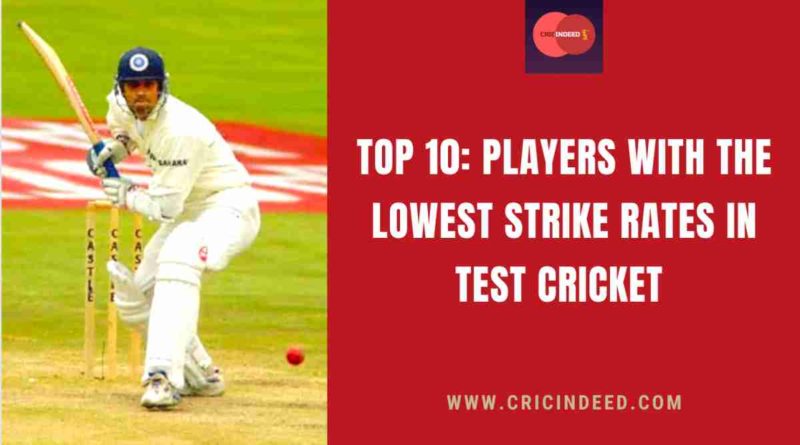Batters often take time to score the first few runs off their bat in Test cricket. At times, the bowling side does so well that even after the batsmen get accustomed to the pitch and the bowling side’s strategy, they must try hard to increase their scoring rate.
In this article, the prime focus would be on the top 10 players with a slow scoring rate throughout their careers. However, still, they formed to be an integral part of the team and helped contribute to many of their team’s crucial wins during their playtime.
Note: The players mentioned in this article are restricted to having at least 5000 Test runs in their career. Let’s get to the list.
#10 Gary Kirsten (SA) – 43.43
Total Runs: 7289
To start with, we have a talented South African batsman, Gary Kirsten. Gary had been successful with the bat not because of any wide range of shots, out-of-the-box things, or aggression. Instead, it was all about his technique and the hard work he had put in over the years. Being an opener, it was never going to be easy for him to have an attacking approach, and the level of bowling sides had been at best during his time as well can be considered as one of the main reasons behind him having such a low strike rate throughout his Test career.
Nevertheless, his consistency helped the Proteas register many important wins. The fact that South Africa had lost only one match when Gary went on to score a Test hundred portrays that Kirsten used to score runs, which mattered a lot to the team.
#9 Shivnarine Chanderpaul (WI) – 43.32
Total Runs: 11867
Only the second player hailing from West Indies to ever reach the magical figure of 10,000 runs in the Test format, Shivnarine Chanderpaul is next on the list. Known for having a not-so-common batting stance, he started his career under the shadows of another great middle-order West Indian, Brian Lara. He was the lone warrior present in the team post-Lara’s retirement.
Chanderpaul proved that it is not always necessary to hit big shots or have a fast striking rate to maintain a fifty+ average throughout the Test career. One can do the same with the help of just giving the ball a direction to go to and play with soft hands. He had been referred to as the rock of a fragile batting lineup, and he held his position strong just by his presence and a strike rate of 43.32.
#8 Rahul Dravid (IND) – 42.51
Total Runs: 13288
Next on the list is “The Wall,” as everyone fondly calls this legendary Rahul Dravid. Mastery of most of the cricketing techniques made him pile up runs consistently.
The former Indian middle-order batter did play one of the slowest innings for an Indian batsman, hitting 21 runs off 140 balls at Nagpur. The first run came out after playing 40 balls. Also, this cricketing milestone depicts how slow and consistent he had been, but he was definitely one of the best to have graced the game’s longest format.
#7 Azhar Ali (PAK) – 41.93
Total Runs: 7142
Recently retired, Azhar Ali is whom we have next. He had brought that calmness and stability to the Pakistani Test team for what they had been searching for before his debut. Batted as an opener in the initial days of his career, he cemented the No. 3 position later in the team. He was among the only few Pakistani batsmen to have a debut before playing an ODI first.
Not only did he perform in the home conditions, but he also had been instrumental in helping Pakistan register many of their wins away from the subcontinent. He used to play quite unhurriedly throughout his career and hence makes the cut to this list with a strike rate of 42.26
#6 Mark Taylor (AUS) – 41.48
Total Runs: 7525
The player we will be talking about is the former Australian left-handed opening batsman Mark Taylor. He is also the joint second-highest score in the history of Test cricket for Australia with a score of 334*.
During the 1989 season, young Taylor, on his first-ever Ashes series, had a great tour scoring 800+ runs, cementing his place in the team. He ended his Test career on a high note by recording an Ashes win. A gun fielder, on the contrary, his striking rates with the bat had been quite low. But being an opener, that’s quite understandable.
#5 Allan Border (AUS) – 40.98
Total Runs: 11174
Allan Border had been a rigid middle-order batsman – the one we have following on the list. As a player who has played the most matches as a captain, he had been consistent not only with the bat but also quite regular with playing almost all of the matches around. He was just 6 short of England’s Alastair Cook’s record of playing the most consecutive matches.
He used to take his time well enough to support the batting lineup and post a great score. To hail his contribution to Australian cricket, the Test tournaments between India and Australia are now called by his name along with the Indian great, Sunil Gavaskar. Also, the best Australian player of the year is given the Allan Border medal every year.
#4 David Boon (AUS) – 40.97
Total Runs: 7422
Like the other batters on this list, David Boon started his career as an opener, only to become one of the best No. 3 Australian batsmen. Unlike many Australians, Boon had been a great player of spin – a reason why he always performed well against India.
However, when the Ashes sides met, Boon performed brilliantly against Australia’s arch-rivals, England. He used to be the main anchor for the team, due to which he used to bat at a really low strike rate.
#3 Kraigg Brathwaite (WI) – 35.59
Total Runs: 5303
Kraigg Brathwaite is the one we have next. Kraig being the only second West Indian batsman in the list should not surprise much because players of that country have been quite great at scoring runs at a really fast pace, irrespective of the format they are playing in. Unfortunately, being the only active player on the list, there hasn’t been much buzz around Kraigg’s contribution, as he has been playing well in the game’s longest format for quite some time now.
Primarily an opener, he has to neglect the moving ball and set up the game. And it is why it should be obvious that his strike rate would be quite less – the third lowest ever in the history of Test cricket with a minimum of 5000 runs scored overall.
#2 Nasser Hussain (ENG) – 40.39
Total Runs: 5764
To get a permanent spot in the side, Nasser Hussain, the next on this list, was ready to let go of his initial batting stance. He wasn’t one of those gifted batsmen, but being persistent and constantly improvising his skills allowed him to debut in 1990.
But all this happened to only getting dropped for a few years until 1996, when he finally made his place permanent in the team. He used to have quite a few flaws as a batsman, but all that did get shadowed by his great stint as a captain. He used to strike the ball at a pretty lower strike rate of 40.39
#1 Mike Atherton (ENG) – 37.32
Total Runs: 7728
Another right-handed batting legend from England, Mike Atherton, takes up the first position on the list. This may not be something to feel proud of, but he had been a great batsman for his side during his stint as an opener.
If not for his low scoring rate, he would have easily broken a few more records by the end of his Test career. He is the only player to have a strike rate below 40 in Tests among anyone with a minimum of 5000 runs in the longer format.



